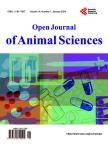Influence of three aphid species used as prey on some biological aspects of the predator <i>Eriopis connexa</i>
Influence of three aphid species used as prey on some biological aspects of the predator <i>Eriopis connexa</i>作者机构:Facultad de Ingeniería Agronómica Universidad de Ciencias Aplicadas y Ambientales U.D.C.A. Bogotá D.C. Colombia
出 版 物:《Open Journal of Animal Sciences》 (动物科学期刊(英文))
年 卷 期:2013年第3卷第3期
页 面:193-199页
学科分类:1002[医学-临床医学] 100214[医学-肿瘤学] 10[医学]
主 题:Predator Rearing Brevycoryne brassicae Macrosiphum Pterocallis sp. The Alder Aphid Glucosinolates
摘 要:Up to now, the search for an efficient artificial diet to rear the predator Eriopis connexa, native to the Colombian highlands of Cundinamarca and Boyacá has been without success. Therefore, it is necessary to determine which of the available preys supply the best food for its development, survival and fertility. With this purpose, under controlled conditions, three aphid species, accessible within the natural habitat of the predator, were evaluated. The cabbage aphid (Brevicoryne brassicae) does not provide an adequate nutrition for the predator, and apparently, the glucosinolate content of this aphid is transferred and affecting the predator. Based on the demographic parameters such as net reproductive rate, finite reproduction rate, generational time and intrinsic growth rate, for three consecutive generations, it was determined that none of the other two aphid species can be considered either as optimum prey. Macrosiphum euphorbiae, as prey stands out over the alder aphid, Pterocallis sp., supplied as food. The influence that these three prey species had on the growth potential of the larval stages of the predator, under particular ambient conditions, is reported.



